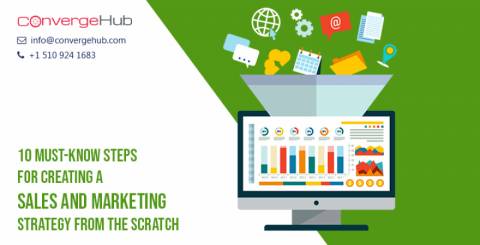10 Must-Know Steps For Creating A Sales and Marketing Strategy From The Scratch

At their best, marketing and sales teams are acquaintances. At worst, they are enemies. At least that has remained the situation in most organizations.
Now, while a bit of healthy rivalry never hurts, the marketing and sales teams in most businesses suffer from miscommunication (or even a complete lack of communication), as well as occasional feelings of animosity. However, this is a matter of concern, especially considering that the two teams in any company typically have the same goal - increase business and revenue.
Therefore, there are certain points to review your marketing and sales strategies to enhance profits and gain ground with reassurance on your competitions.
As one of the most popular vendors of CRM for small and medium businesses, we feel that a great way to start creating a sales and marketing strategy from its scratch is by dismantling the entire process into manageable and discrete elements, which can help you to build a checklist of the steps that can be monitored and reviewed to prioritize areas that require improvements and so serve as a groundwork for creating a strategy that can usher both revenue and business growth.
Step #1
Research Your Markets
In the very first step as a part of our business growth training and ideas, it is advisable to research your present and future markets to learn why the consumers buy from your brand and what more you can offer them to attract more customers.
For this, it is best to identify ways to sell more to the customers who are most profitable for your business and thereafter try to find out if there are chances for selling in the industrial, bulk, institutional or corporate markets beyond normal online or retail establishments that you have been ignoring in the past.
This data when collected in an easy-to-use CRM can help to determine if any new feature or services can attract more new customers to your brand or if people are ready to pay more for bringing innovations to your offerings.
The best possible way for collecting this information is by studying what your completions are doing and by gathering information about your customers.
Most businesses use surveys to gather this data, but you can even establish customer loyalty programs that require participants to register by providing some basic information about themselves, which can help to understand what demography you are enticing (or failing to attract) for your brand.
Step #2
Find Your Competitions
Do you know what your competitions are really up to?
Or, what are the overall current marketing trends?
Or, how your business is holding up in terms of market share and profitability?
How do you rank against your competitors, or what substitutes there are to your products and services, and how much of a threat they do pose for your business?
Hence try using competitive intelligence to enhance and maintain your brand’s market share, which might involve proactively researching what your competitive brands are offering, their pricing, or what marketing and sales strategies they are using to sell their product and services in targeted demographical locations across the globe.
Step #3
Secure distribution
Once you are aware of your markets and your competitions in the very next step, try to identify ways to make your offerings accessible to new outlets profitably.
Now, this can suggest increasing your online sale, contacting additional retail outlets, expanding your delivery options, and more.
In other words, try to find out mutually beneficial ways to collaborate with other businesses that require your offerings.
For example, as an event management company, you can work with local caterers and florists to offer them purchasing options that include your services, which can allow both parties involved in the trade to expand their customer-base jointly.
Step #4
Reevaluate supply chain
For enhancing your businesses’ profits, perform research on suppliers to find multiple options available when possible to free your company from the mercy of limited wholesalers who might increase prices for supplying the raw materials or other product components required for manufacturing and delivering your offerings.
If your company can manage suppliers more effectively, by using multiple wholesalers you can easily keep production costs in check.
Therefore, always remain on the lookout for new suppliers in the marketplace who might be willing to offer your business deals to boost your business revenue, or find prefabricated items in the marketplace which can signify cost savings over, doing it all by yourself.
Step #5
Redefine positioning
As we have said even earlier while discussing how you can start creating a sales and marketing strategy, it is important to know who are your competitors and where your brand fits in the marketplace.
Toeing the same lines, we would now like to suggest that zeroing on specific demography (such as those consumers who want quality item and services or those who only looks for discounted products) might help to improve your brand’s market share by targeting the demography that fits best with the kind of offering that you sell and want to position yourself as a brand.
Step #6
Advertise promotions
Is it not a better job to reach your potential leads and customers by figuring out where they are and not look for them everywhere?
Hence if you are trying to reach your best leads and audiences through social media, it is always good to know which age group is using which platforms for promotions of your brand’s offerings.
This is because a survey done by Pew Research Center in 2019 it illustrated that adults are twice more likely to be on Facebook and LinkedIn than on Instagram.
Step #7
Review pricing
To make sense for everything that your business offers review the pricing strategy at a specific interval.
This is because external factors such as product availability, consumer demand, and many other factors can play a role in how much you should be charging for the goods and services that you are selling in the marketplace.
For example, if you are running an ice cream shop in a town that draws a lot of tourists during the summer months, it might be fair to charge a premium for the items on your menu when the demand is high or more customers are entering your store. However, during the colder months when the tourists are gone, you must update your menu and cater to winter-themed items at a discounted price to keep the business running steadily.
Step #8
Provide excellent customer service
The very first step to providing good customer service is to understand the kind of service that your customers want from your brand.
For example, if you run a convenience store where consumers stop for a quick grab of a power bar or soft drinks, they will simply look for a friendly cashier to take care of their transactions without any hassles, quickly. However, for a full-service restaurant that offers more, will draw people who are looking to be waited on or have their questions answered for more specific issues.
Additionally, for creating a sales and marketing strategy it is important to seek the feedback of your customers and provide ways for customers to review your business.
Hence create loyalty programs and regularly keep in touch with existing customers who have not made any purchases for a while to offer them discounts or inquire why they have not visited your business recently.
Step #9
Seek financing
Make sure that you review your businesses’ capital structure on a regular basis or have a professionally trained accountant to do the job for you to ensure that you are handling the liabilities and assets of your company most cost-effectively.
This is because as business establishing if you achieve some success, and is viewed as a stable business in the community which has a solid reputation, you might as well be able to attract venture capitalists and angel investors to assist you in your business expansion plans.
Step #10
Ensure consistent strategies
Increasing sales and building customer loyalty for the existing customers should be a constant focus of your business.
Now bringing people to the door at times requires different approaches based on the needs at that time.
For example, if the spring months are typically slow for your brand’s business, it is a good idea to schedule special events during those months that are designed to bring potential customers in the door.
Takeaway
To conclude, as one of the most recognized vendors of easy to use CRM tools, we would suggest that you should never limit yourself to strategies built around sales for creating a sales and marketing strategy, but rather let sales come naturally from that boost of attention which your business can find by centering activities around the products and services that you cater to draw your potential consumer’s attention in this ever-changing and dynamic marketplace
Similar Articles
The presence of reserved signs from Inkohoreca on tables becomes visible as soon as you enter a restaurant. Despite being a small element the reserved signs help a restaurant operate more effectively.
In the current era, the term packaging definitely refers to more than just a technique to keep a product safe, instead, it serves as an essential factor for the quality of the product, the brand’s reputation, and overall customer experience
Learn why failing to blur video footage in your business can lead to privacy violations, legal fines, and reputational damage. Protect identities and stay compliant.
Want to know which business video ideas actually work? The numbers tell a powerful story—84% of people say they've purchased a product after watching a brand's video, and social media videos alone have helped 93% of brands attract new customers.
Running a wellness business can be incredibly rewarding, but it also comes with many challenges. From managing appointments and handling payments to marketing your services and keeping customers engaged, there’s a lot to juggle
Efficient management is the backbone of a thriving fitness studio. By leveraging fitness studio scheduling software, you can streamline your operations and enhance the member experience. This robust tool allows you to organize classes, manage appointments, and coordinate staff schedules seamlessly.
Event marketing and trade show exhibitions depend on the use of attractive, engaging, and well-placed booths that captivate and retain the attention of the viewers. Portable custom event displays remain essential because they allow effective visitor engagement and improve brand visibility, resulting in customer conversion.
Imagine this: You’re running a busy restaurant, and suddenly, your walk-in fridge fails overnight. By morning, thousands of pounds worth of food is spoiled.
In businesses and offices, completing signature tasks quickly and accurately is essential. The right tools can greatly reduce time spent on routine paperwork.









